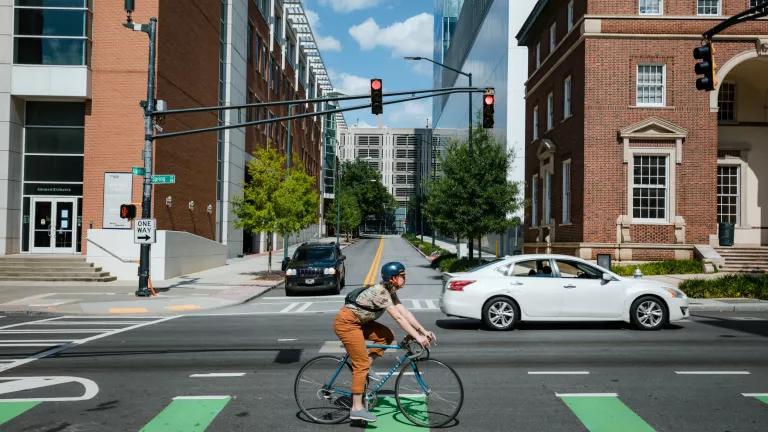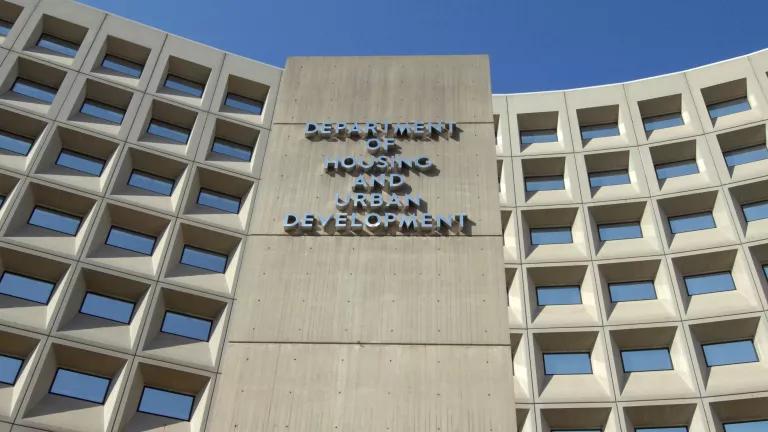Good Jobs through Climate Action: The High-Road Path
Ambitious action on climate change carries huge potential for job creation. Done correctly, it can be leveraged to expand economic opportunity for people of color and others long excluded from career-track employment.
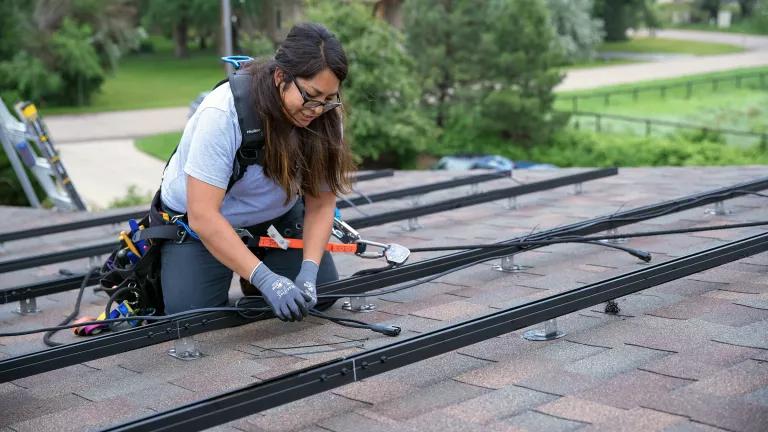
Joe DelNero/NREL, 80603
Co-authored with Betony Jones and Jodi Pincus, Inclusive Economics
Ambitious action on climate change carries huge potential for job creation. Done correctly, this potential can be leveraged to expand economic opportunity for people of color and others long excluded from career-track employment. Done incorrectly, climate actions and workforce training are likely to do exactly the opposite: grow insecure low-wage jobs with limited upward mobility and perpetuate exclusionary practices.
The newest resource from Bloomberg Philanthropies’ American Cities Climate Challenge, the High-Road Workforce Guide for City Climate Action, provides cities with step-by-step guidance to align climate goals with equity and economic recovery goals. This strategy also happens to parallel the Biden-Harris Administration’s priorities of creating good union jobs, addressing racial equity, and tackling climate change. Developed by Inclusive Economics for the Climate Challenge, the guide provides a framework for cities to evaluate and shape workforce initiatives with solutions that meet growing demand for workers while creating equitable access to good career-track jobs.
Job Training Does Not Create Jobs
Conventional ideas of ‘workforce development’ and ‘green job creation’ mostly focus on worker training programs. Racial equity in this limited vision simply means getting previously disadvantaged or disenfranchised individuals into those job training programs. A high-road workforce strategy recognizes that job training does not create jobs and that the wrong kind of training can actually drive down wages by flooding the labor market with an excess supply of workers. Aligning the supply of workers with the actual, measured demand for workers is essential, which is why stand-alone job training programs do not result in better jobs or better job access. Calibrating the number of people trained to the jobs that exist can achieve this equilibrium and ensure real opportunities for people looking to enter the workforce.
Over the last two and a half years, the American Cities Climate Challenge has worked in partnership with Inclusive Economics and Emerald Cities—organizations helping to reshape the conversation around workforce initiatives and inclusive economic development—resulting in a pivot within the Climate Challenge away from a focus on trainings to a focus on actual jobs created or likely to be created, their ability to provide career advancement and family-sustaining wages, and the connections and support systems needed to get and keep previously excluded individuals in those jobs. This, in turn, has enabled us to support the cities in the Climate Challenge to develop and implement more holistic and equitable workforce development initiatives.
Defining High-Road Jobs: Job Access AND Job Quality
In the past, job access and job quality were most often thought of as two ends of a spectrum. Job quality is associated with more skills, higher wages, and higher barriers to entry. Job access is thought of as entry-level, easy to access, lower skills, and low wages. Generally, as the quality of jobs improves, they are harder to access and more exclusionary. The new paradigm of a high-road workforce strategy challenges this conventional thinking. With intention, we can and must shape jobs to be both high quality and inclusive.
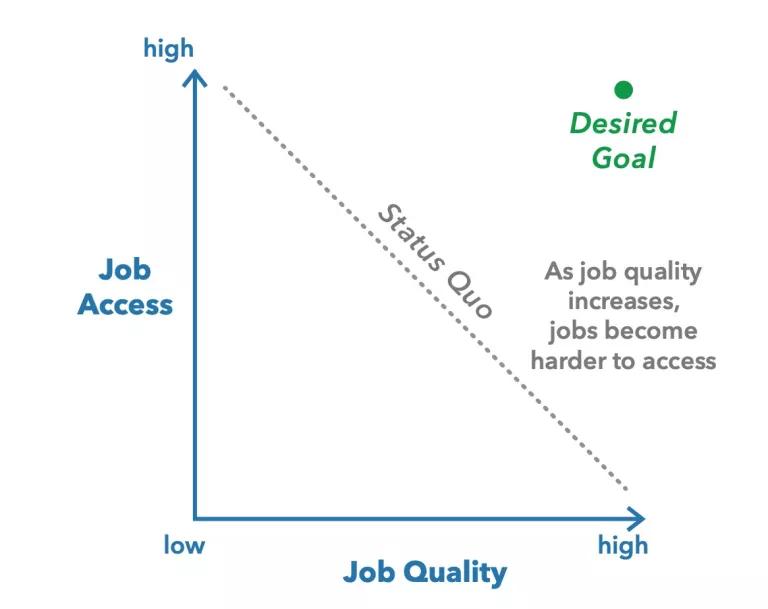
Conventional Thinking
Developing a high-road workforce strategy means pursuing job access and job quality simultaneously. It requires improving the quality of jobs so that they are better able to support workers’ economic self-sufficiency, upward mobility, and overall welfare while simultaneously improving access to jobs for people who have been historically excluded from career-track, family-sustaining employment and training opportunities. Well-designed climate action can ensure that job quality and job access improve in complementary fashion.
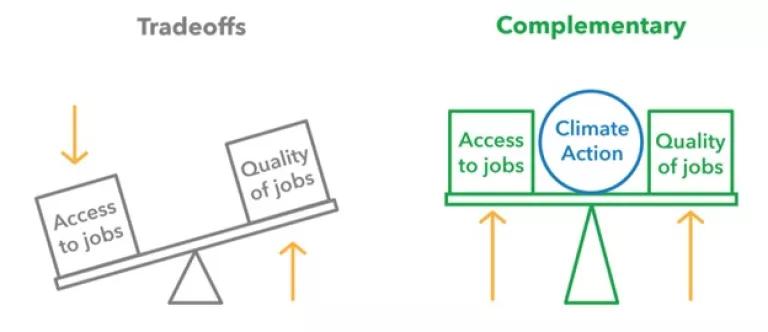
Conventional Paradigm vs. New Paradigm
Assessing the Workforce Ecosystem to Identify Gaps—and Fill Them
Beyond training programs, there are numerous interventions cities can take to foster high-road workforce development: credentialing, wage requirements, procurement and contractor standards, targeted hiring, labor agreements, facilitated entry, support services—the list goes on and on (and in much more detail in the Guide starting on page 54). Too often, a workforce development landscape includes programs that train participants for jobs that do not exist or that potential trainees are unable to access.
Balancing workforce supply and demand (figure below) is about making sure that interventions on one side of the labor market translate into benefits on the other side. The guide provides a framework for conducting a workforce assessment or “gap analysis” to better understand the issues surrounding a city’s clean energy labor market. This can help identify employer needs, the characteristics and skills of local workers, and the gaps between the two, ultimately to identify the types of solutions most applicable to that particular market and the city’s specific goals.
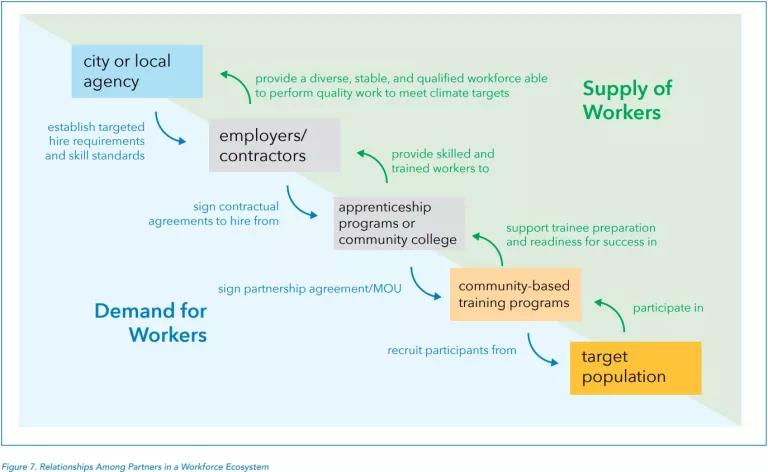
Relationships among partners in a workforce ecosystem
City Actions on High-Road Workforce Planning
Through the Climate Challenge and with the technical support of Inclusive Economics many cities have begun their high-road workforce strategic planning process:
- Denver, Colorado’s sustainability and economic development departments have teamed-up to develop Denver’s Clean Energy High-Road Workforce Vision, which includes their priorities, metrics for success, and an implementation strategy for their Climate Protection Funds, as well as influencing the City’s Building Performance Standards workforce and labor standard policy recommendations.
- St. Paul, Minnesota developed a cross-sector collaboration called Building Green St. Paul, involving industry, the building trades unions, government, and community-based organizations committed to climate resilience, equity, and workforce development in the construction and energy industries. Building Green St. Paul works to support Saint Paul’s larger goals of carbon neutrality by 2050 achieved in a way that benefits marginalized and frontline communities. This partnership is launching its first training cohort in July in partnership with a local organization that works with formerly incarcerated Black men.
- Across all 25 Challenge cities, Inclusive Economics and NRDC have partnered with the Electric Vehicle Infrastructure Training Program (EVITP) and International Brotherhood of Electrical Workers (IBEW) to train 1300 union electricians and apprentices in the skills required for safe and effective electric vehicle infrastructure. Half of the individuals trained through this partnership will be women and BIPOC workers.
Building a High-Road Workforce Strategy
With cities undertaking major climate actions and economic recovery at the forefront of every city’s agenda, there is an opportunity for cities to think critically about the kinds of jobs they want to support through their climate actions. Cities are beginning to see that their climate actions can work to stimulate workforce and economic development. Furthermore, the design of city climate policies and programs will influence the quality of jobs created in the local economy and who is able to access them. With intention, cities can create resilient local economies with good family-sustaining jobs and access for workers long-excluded from career-track opportunities, ensuring that no one gets left behind as we transition to a more sustainable future.
Inclusive Economics is a mission-driven consulting firm providing customized economic research, strategy, and policy advising to grow an equitable green economy. Inclusive Economics engages with organized labor and community-based organizations to build political will to move further faster on climate policy. Inclusive Economics is a national partner of the Bloomberg Philanthropies American Cities Climate Challenge. Visit us at www.InclusiveEcon.com.
The Bloomberg Philanthropies American Cities Climate Challenge is an initiative that empowers 25 of the largest U.S. cities to implement near-term climate goals and become primary drivers of progress towards meeting America’s pledge on climate. Recognizing that cities account for more than 70% of global carbon emissions—and that mayors have significant authority over cities’ highest emitting sectors: transportation and buildings—the Climate Challenge aims to enhance the work already being done by mayors across the U.S. and to support cities in the fight against climate change.



